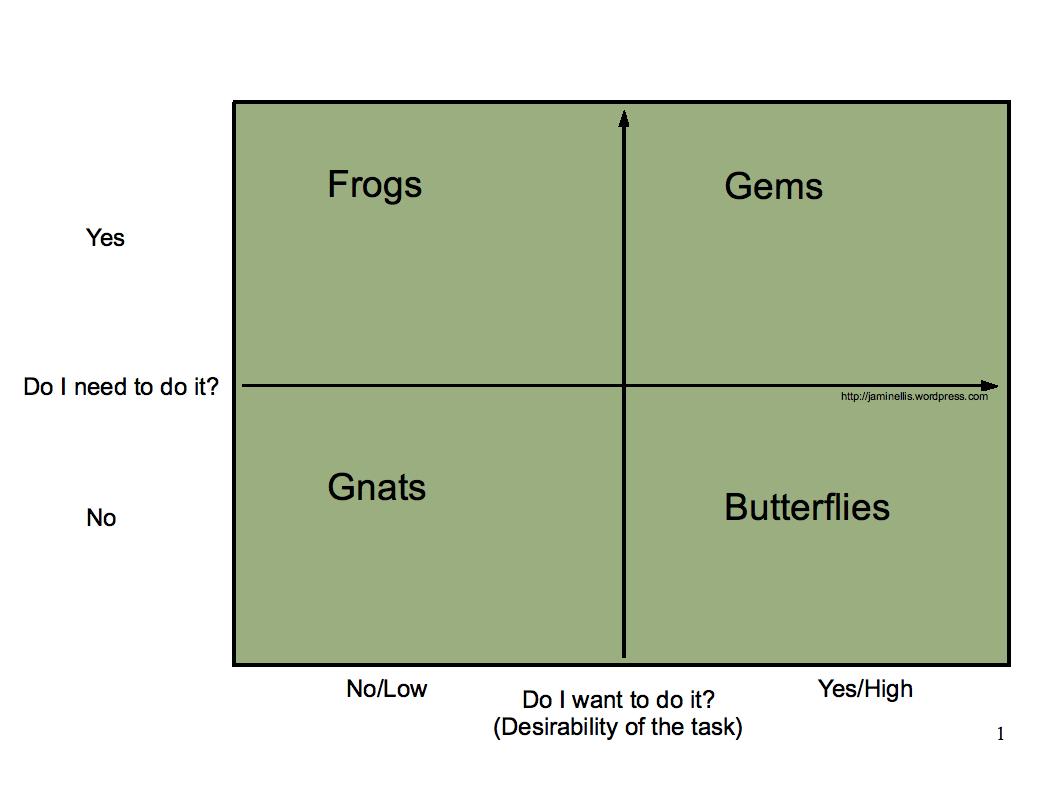Frogs, Gnats, Butterflies and Gems.
It has been a long while since I wrote my original Watch out for the frogs post (you might want to read that first if you missed it), which was picked up on lifehack.org. It has been fun to see the post translated into more than half a dozen languages, referenced in seminars, and read by thousands of people. Thank you all for some thought provoking comments and emails!
The key point of my frogs/gnats/butterflies/gems model was to assess the next task with two questions:
- Do you want to do it? The desirability of the task.
- Do you need to do it? The necessity of the task.
This is not so much about prioritising tasks, it is more about tackling the right things at any given moment. There is a subtle difference between prioritising tasks and tackling them. All too often people have a well prioritised task list, but still use their time to tackle the wrong things. Thinking of a given activity as a gnat, frog, butterfly or gem can help create personal accountability for whats gets tackled.
Why four types of task, two questions? Very simply to embed a reality check at the start of each activity. The necessity of the task is a key filter to apply before carrying it out, but the apparent necessity is always going to be biased by our motivation. Our motivation is driven by the desirability of the task, which is why we need to be aware of it. Have you ever found yourself justifying how important something is, in order to pick on that task and push off another? It is in our nature to justify our preferred choices, almost regardless of the actual logical reasons. Questioning our motivation disarms this habit. At the transition point between activities, as you end one activity and start the next activity is a key moment. Pause to understand the nature of the next task, to ensure it is the right next step. Use the two questions or four types of task:
- GNATS – Things you don’t want to do and don’t need to do.
- FROGS – Things you don’t want to do, but do need to do.
- BUTTERFLIES – Things you do want to do, but don’t need to.
- GEMS – Things you do want to do and do need to do.
Asking the want question helps us to understand our motivation towards the task. If you want to do the task, you need to ask yourself questions:
- But is this the best thing for me to do right now?
- Is there something that I don’t want to do, that I should be doing?
Jumping to an attractive task can actually be a form of procrastination, you just happen to be procrastinating by doing something. Picking up a butterfly instead of eating a frog is not a productive thing to do. Chasing a butterfly does feel fun and is easy. Unfortunately, it leaves that ugly frog sitting there croaking “guilty! guilty!” at you.

By default, people tend to view tasks as Gnats or Gems, in reality they are usually frogs and butterflies. Understanding the nature of tasks in this way clarifies how to approach them and stops the wrong things sneaking through:
Gnats: Is it a gnat or is it a frog in disguise? If it is a gnat, go ahead and brush it off, it is low priority. If it is a frog, then do it, now.
Frogs: Frogs either hide themselves as gnats, or puff themselves up into the ugliest toad you ever did see. The ‘frog’ tasks are never as bad as they seem, after they are done. The longer they are left, the uglier they get. This is procrastination at its worst. Dive in there and at least tackle a piece of the task, if not all of it, as soon as you can.
Butterflies: Butterflies flutter and flap and do their best to look like gems. They aren’t, they are just flights of fancy, and another form of procrastination. Avoid them, other than as a special treat when all the frogs and gems are done.
Gems: Is this a gem or is it a butterfly in disguise? Gems are rare, enjoy them when you find them, they are the core of a well motivated and productive life. By getting rid of the frogs first, gems become more enjoyable. No croaking noises in the background means that you can be free to truly enjoy doing the gem. We are always motivated to push through to the gems, which is why it is so important to put the frogs ahead of them.
Go ahead, subvert the best attempts of your brain to procrastinate. Instead, focus on using your time well, to reduce the frog-induced stress in your life and enjoy a new found productivity.
Name checks to some of those who wrote about the original article, who’s blogs I now read:
- The Simple Productivity blog – it is simple and is about productivity, very neat.
- Daily Plan It – I have been enjoying reading this blog. The Hop to It post has a link to a ‘frog eating form’ from Marcia, which looks like a great way to call out your frogs and ensure that they get eaten.
Related posts:
Watch out for the Frogs, How to Deal with Being Overwhelmed at Work


[…] What Needs Doing and Do It! Living a Productive Life) has written another excellent article about Frogs, Gnats, Butterflies and Gems, and how they masterfully disguise themselves so we won’t recognize their true […]
I like this.It’s an original and creative way of looking at tasks.